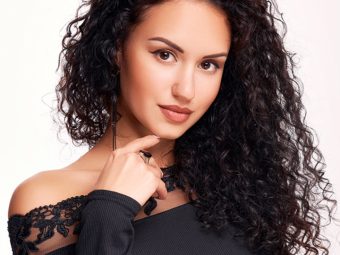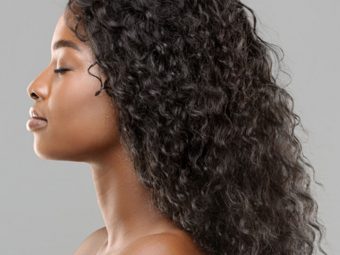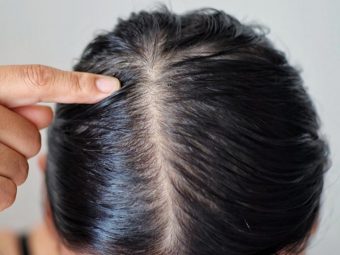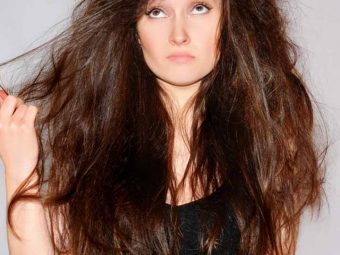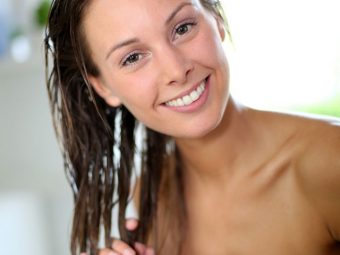Damp Hair: Everything You Need To Know About It
Fell asleep right after washing your hair? Just follow some easy tips to prevent damage!

Did you ever doze off with damp hair right after a late-night shower? If yes, you may have noticed that your hair was not completely dry when you woke up. Some of it may have even felt rougher. Why does this happen? Let us explain.
Damp hair, or partially dry hair, is fragile. The strands of your ‘neither-dry-nor-wet’ hair become a tangled, knotty, and matted mess. Sleeping with damp hair leaves your scalp vulnerable to infections and makes it smelly and itchy. It also increases the chance of hair breakage. Continue reading to know everything about damp hair and what you can do to protect your tresses and scalp from the damage it may cause.
In This Article
What Is Damp Hair?
Damp hair is hair that is neither completely dry nor dripping with water. Water opens up the hair cuticles partially, making them elastic and porous. This makes the hair extremely fragile and breakage-prone. Hence, you have to be gentle with damp hair.
Do not confuse damp hair with wet hair. If you are wondering how they are different, scroll down.
How To Differentiate Between Damp And Wet Hair?
The moisture content of damp hair is different from that of wet hair. Wet hair is completely soaked and dripping with water. However, damp hair is 70%-80% dry. It does not drip water, but you can feel the moisture in your hair when you touch it.
Applying styling products like styling gel, wax, or pomade traps moisture in the hair strands and gives you the popular wet, sleek, gel-styled look. This hairstyling trend is known as the “wet hair look” and is not to be confused with actual wet hair.
Leaving your hair damp for a long time or sleeping with damp hair can expose your scalp to infections.
What Happens To Your Scalp Health When You Have Damp Hair?
Damp hair makes your scalp susceptible to fungal infections as the moisture creates a favorable environment for the growth of microbes. Keeping damp hair pinned up or tied in braids, buns, ponytails, and dreadlocks can cause itching, irritation, and a dry and smelly scalp.
When you sleep with damp hair, the moisture in your hair and the warmth in your scalp, along with the damp pillow, create the perfect breeding ground for mold and bacteria. This may cause scalp conditions, such as mold, mildew, dandruff, folliculitis, seborrheic dermatitis, and eczema.
Here are a few things you should never do if you love your hair and scalp and want to keep them healthy.
Things You Should Never Do To Your Damp Hair
Exposure To Excessive Heat: Ever heard that popping sound or sizzle while curling or straightening your damp hair? That is the sound of water evaporating too quickly through the hair, causing structural damage. Hence, be careful while using hair straighteners and curling irons on damp hair.
Exposing damp hair to high temperatures (175°C -215°C) even for five minutes can cause hair damage (1). Excessive blow-drying and using hot irons can change the hair texture and cause breakage, making your hair unmanageable and frizzy (2). To minimize heat damage, dry your hair completely in a cool setting and use a serum, heat protectant, or thermal styling gel on your damp hair.
- Brushing Damp Hair: Do not use a hard brush on wet or damp hair as it stretches the hair and causes breakage. You may instead use a soft brush. To avoid damage, apply a detangling product once your hair is 90% dry and use a wide-toothed comb to remove knots and tangles.
- Tying Up Damp Hair: Let the hair dry completely before tying it into a ponytail, a messy bun, or any other hairdo. Tying damp hair restricts the airflow, creating a moist environment for microbial growth.
- Applying A Hair Mask: Hair masks must be applied to wet hair as they offer deep conditioning. The masks also repair hair damage and make hair feel softer.
There is yet another thing that you should avoid doing – sleeping with damp hair. What happens when you do it? Find out next.
What Happens When You Sleep With Damp Hair?
Sleeping with damp hair will make it matted, tousled, and tangled. This damages the hair, causing split ends and breakage.
It may also cause sinusitis, headache, and rhinitis through a mechanism called selective brain cooling, especially if your hair is wet from a cold weather. You may even catch a cold when your body cools down, causing upper respiratory tract infection and other allergies (4).
Moreover, as discussed above, sleeping with damp hair increases the risk of microbial infections and scalp acne.
However, if you cannot avoid sleeping with damp hair, here are a few tips.
How Do You Sleep With Damp Hair?
- Dry Your Hair: Use a microfiber towel to gently squeeze out excess water from your hair. Let it air dry. Avoid rubbing your hair vigorously with the towel. If possible, use a blow dryer on a cool setting to quickly dry it as much as possible.
- Switch To Silk Pillowcases: Silk pillowcases are non-absorbent and help maintain the moisture balance. They are gentle on damp hair and reduce friction to prevent breakage. They also have antibacterial properties (5). However, ensure you wash the pillowcases regularly.
- Avoid oiling your hair: Oiling wet or damp hair is not recommended. You may instead oil your hair before you wash it (when it is dry).
- Use Coconut Oil: Coconut oil helps moisturize the hair and prevents breakage (6). Apply it along the length of your hair to keep it healthy. Avoid oiling the scalp.
- Use A Conditioner: Hair conditioners contain conditioning agents that coat your hair strands to flatten your cuticles and prevent friction, frizz, knots, and hair breakage. If you have chemically processed hair (bleached or dyed hair), use a conditioner regularly.
If you plan to bleach or dye your hair, you have to be extra cautious as the hair is fragile when it is damp.
Can You Apply Bleach On Your Damp Hair?
Yes, you can apply bleach on damp hair, especially if you want to sport a balayage. When the hair is damp, the cuticles open up, making it easy to bleach. However, bleaching damages the hair, so you have to be careful when using bleaching agents. The same is applicable for hair dyes. Also keep in mind that damp hair may dilute the bleach (bleach developer already has some water content) and make it less effective.
Can You Dye Damp Hair?
You can dye damp hair as partially open cuticles help in better hair dye penetration. However, the excess moisture may result in uneven application and dilute the hair dye, affecting the color payoff. Hence, opt for semi and demi-permanent hair dyes if you want to dye your hair while it is damp.
Water makes your hair strands more porous and elastic, which leaves them vulnerable to breakage. While damp hair is 75% dry, you still need to be gentle with it to avoid damage. This means that you should not sleep with your hair damp. Keeping your hair damp for too long leaves your scalp open to fungal infections. Tying damp hair in hairstyles like braids, buns, twists, and ponytails may cause your scalp to become itchy, irritated, dry, and smelly. In certain cases, damp hair may even lead to scalp issues like dandruff, folliculitis, eczema, and seborrheic dermatitis. Scroll back up to read the additional tips in the article to help you care for damp hair.
Frequently Asked Questions
Can you curl damp hair?
No. It is best not to curl damp hair using curling irons or any heat styling tools as damp hair is more susceptible to damage and may lead to scalp burns.
Key Takeaways
- Damp hair is fragile and more prone to breakage.
- Sleeping with damp hair may cause mold, dandruff, eczema, and more.
- Though you can bleach damp hair, it may dilute the bleach and make it less effective.
Sources
- A practical, algorithmic approach to diagnosing hair shaft disorders
https://onlinelibrary.wiley.com/doi/full/10.1111/j.1365-4632.2010.04768.x - Void and pore formation inside the hair cortex by a denaturation and super-contraction process occurring during hair setting with hot irons
https://pubmed.ncbi.nlm.nih.gov/21635840/ - Bubble hair: a cosmetic abnormality caused by brief, focal heating of damp hair fibres
https://onlinelibrary.wiley.com/doi/abs/10.1111/j.1365-2133.1994.tb08599.x - Acute Cooling of the Body Surface and the Common Cold https://www.researchgate.net/profile/Ronald_Eccles/publication/11099267_Acute_Cooling_of_the_Body_Surface_and_the_Common_Cold/links/0deec518fe33a054bc000000/Acute-Cooling-of-the-Body-Surface-and-the-Common-Cold.pdf
- Antibacterial properties of silk fabric treated with silver nanoparticles https://www.tandfonline.com/doi/abs/10.1080/00405000.2015.1129756
- Hair Cosmetics: An Overview
https://www.ncbi.nlm.nih.gov/pmc/articles/PMC4387693/




